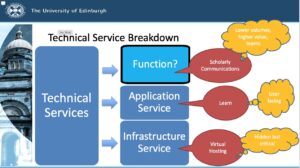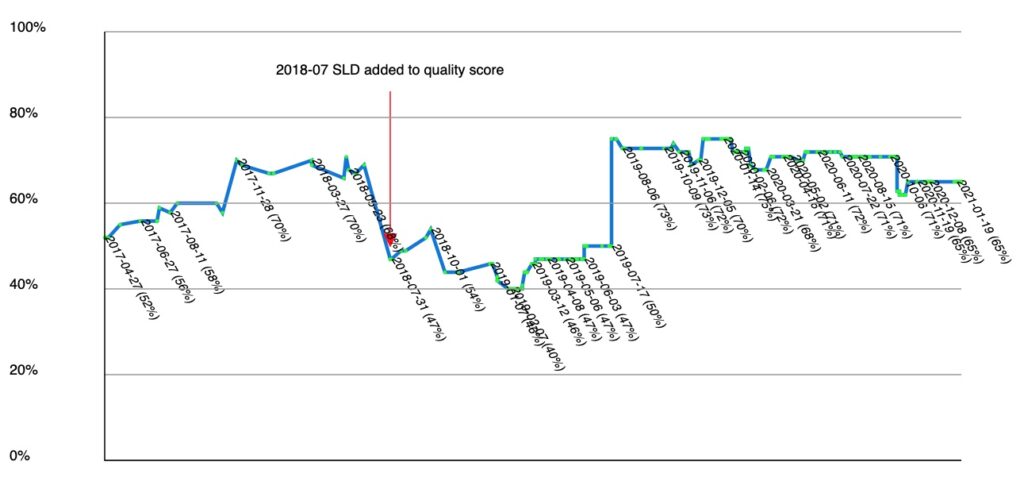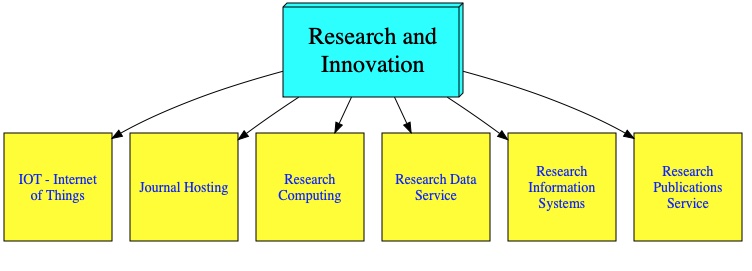Five Years of Service Catalogue
A Catalogue Is Born

Lots of verbs and nouns but not necessarily services.
At the start 2016, the Library and IT “catalogue” was an A-Z with 159 “services”. They were not all services. A management spreadsheet had reduced this list to 108 candidate entries. Clearly everyone and everything was declaring “I’m a service”. Of course, people will shout “But we did have a catalogue!”. Yes, I am sure there were many, known only to those who created them. Like imaginary friends, not seen by anyone else.
To bring order we needed an agreed framework – a schema, definitions, agreed starting point and rules for future inclusion, modification removal. The first objective was to identify our portfolios and business services – which would be a simple, hierarchical list. The resulting list might be simple but the politics of getting there were more challenging.

Our schema ensures hierarchical organisation does not go below Business Service level to maintain simplicity. Copyright 2016 The University of Edinburgh Author James Jarvis
Agreeing a “starting catalogue” was a priority. Scheduling senior managers to meet and agree required a lead time in months. There were a lot of candidate catalogue entries to whittle down. The concise invite instructions:
Objective: Sign off Business Service Names, Owner/SOM Roles and classifications, identify collaboration areas were services transcend divisional boundaries.
Preparation: None requested – materials will be provided on the day
Delegation: If you send a deputy it is on the understanding that they are authorised to make decisions.
helped ensure the outcome would be delivered. Fuelled with tea, coffee and biscuits, the managers were split into two groups with 50+ services each (about 2 minutes per service). It was pressured but fun. They enjoyed the format and delivered.

The Library and IT Business Service Catalogue was born on Wednesday 2 March 2016, at 21 Buccleuch Place, Edinburgh
Copyright 2016 The University of Edinburgh Photo: James Jarvis
The resulting catalogue was widely accepted but there were still some service owners who felt their importance had been overlooked. The requirement that service owner of business services would need to have their photo alongside the service entry was also contentious with some. The realisation that it was “safer” to be a valued, underpinning, technical service was yet to be grasped.
That first catalogue had seven portfolios and 78 services.
Going Deeper – Technical Services
The Business Services are intentionally high level. Underneath a myriad of functions, applications and infrastructure provide the building blocks for the service delivery. In theory these buildings blocks could be replaced or removed. In practice, some of these building blocks underpinned multiple business services. The catalogue was demonstrating some technical services underpinned multiple business services. A technical service could be more business critical than a business service. This was welcomed by the technical service providers – they were valued but were not required to have their photo published.

Technical services were recorded as either a function, an application or infrastructure.
Copyright 2018 The University of Edinburgh
Sharing The Catalogue
The catalogue itself is stored in a bespoke web database application. The application has an “application programming interface” (API) that exposes the data in JavaScript Object Notation (see JSON). This allows, for example the University Website to pull an updates in the catalogue automatically.
Lessons Learnt
Avoid Perfectionism
It is far better to have poor quality entries in the Catalogue than to pretend they don’t exist. A perfect catalogue should not exist! A perfect catalogue may be an indication of a very incomplete catalogue.
Be Flexible
Despite best intentions, processes get by-passed.
Early on the idea of a form for requesting entries was very enticing. In practice, an individual (usually the service owner) requests a service catalogue entry only very occasionally.
The initial entry is often best achieved by having a 15-30 minute meeting to populate the catalogue fields in a first draft. This allows the service owner to go away with actions to fill the gaps. It allows the service catalogue manager to articulate the context of the service within the wider service portfolios, pointing out relationships with other services and stakeholders that would otherwise be overlooked.
Measure the Catalogue

Each service is scored on the quality of the catalogue entry. This graph shows the average service score over time.
Measuring the catalogue itself is useful Catalogue entries are given a % score to indicate how well kept they are. Regressions can then be addressed…
Tracking the overall quality of service entries in the catalogue should be a key performance indicator of the catalogue itself.
Entry Enables Retirement
One colleague shrewdly submitted an entry for a legacy application they needed to retire. By getting the entry into the catalogue, they would be able to access a process for retirement.
Visualisation is vital.
At the right. At the right time. The full catalogue map can be a monster. Mostly this monster should be hidden (but showing it can stop over-simplification talk in its tracks 😀).

The full graph diagram of the catalogue can be very busy but is useful to illustrate the bigger service context.
Being able to show local visualisation is of course essential. The catalogue API has allowed the generation of traversable snippets of the catalogue, allowing colleagues to navigate to adjoining nodes.

Example of a Service Portfolio (Research and Innovation) and its Business Services
Copyright 2021 The University of Edinburgh
Graphed using GraphViz Software
Value Realised
So what is the return on investment in the catalogue?
-
- Improved Accountability – Having a named service owner clarified expectations. The service owners responded accordingly. Services improved.
- Risk reduction – Vacant roles gave senior management a spotlight on risk. If senior management had no delegate in place, then accountability was theirs.
- Support Transparency – clarity of:
- what is supported
- what is not supported
- escalation routes
- service relationships and documentation
- Efficiency gains – over time a number of overlapping services were either retired or merged into a single coherent offering with service offerings.
- Relationship Management – customer issues often encompass the interaction of many business processes. The catalogue has provided a tool for identifying key stakeholders to address customers concerns.
The Road Ahead?
This is my final post in the ITIL Team, so it feels like the end of the first chapter of the catalogue. Whilst it is sad to leave the University, the outlook for the Service Catalogue is optimistic.
Since the birth of the Catalogue it has extended to include the Finance & Procurement portfolio at the start of 2019 and Student Lifecycle Services in 2020. The Technical catalogue has increased to 237 entries. The Business Services has reduced to 70.
My wish is that the scope of the catalogue will grow to include all service areas of the University into one service catalogue. Services, and therefore Catalogue, transcends organisational units.
At its most simple, the catalogue is the single source of information on services that any new student or staff member would instantly be able to navigate.
And with that I will bid farewell, and wish everyone a brighter future…
James Jarvis, 1st February 2021

Heading into the sunset





Recent comments